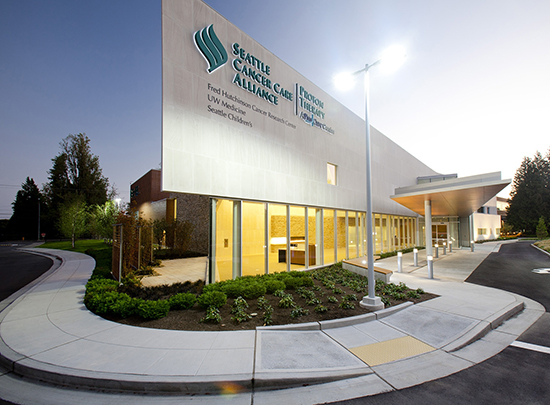|
Subscribe / Renew |
|
|
Contact Us |
|
| ► Subscribe to our Free Weekly Newsletter | |
| home | Welcome, sign in or click here to subscribe. | login |
Construction
| |
 |
May 17, 2013
Cast-in-place structures
Seattle Cancer Care Alliance Proton Therapy
Location: Seattle
Owner/developer: Seattle Cancer Care Alliance and ProCure
Project team: Hoffman Construction, general and concrete contractor; Tsoi/Kobus & Associates, architect; Cary Kopczynski & Co., structural engineer; CalPortland, ready-mix supplier
A two-story, 54,000-square-foot concrete cancer-treatment center was built on a 2-acre site on the Northwest Hospital & Medical Center campus in Seattle. The ProCure proton-therapy facility, developed in partnership with the Seattle Cancer Care Alliance, is the first in the Pacific Northwest to offer proton therapy to cancer patients.
Proton therapy can more accurately target tissue needing radiation exposure than standard X-ray treatment, so radiation of healthy tissue is minimized. Using a cyclotron, protons are accelerated and delivered to patients for treatment.
Because protons are radiation particles, they require shielding. Research found that a 9-foot-thick, high-density concrete bunker will properly contain the protons. So the SCCA facility included massive concrete containment structures to provide proper shielding.
Once constructed, it took a year to install and calibrate the equipment, including the 220-ton cyclotron, which required a heavy concrete structure to support its weight.
The project posed special challenges from the design and construction team:
• The structural engineers designed concrete shielding walls and decks ranging from 5 to 14 feet thick. The size of the shielding elements was calculated based on the density and thickness required to contain high-energy protons. “Key ways” were placed in the concrete construction joints to ensure protons were properly contained. A zigzag-shaped concrete entry maze to the treatment areas provides additional containment of protons.
• The bunker required a special concrete mix design to achieve consistent density that exceeded 150 pounds per cubic foot — the technical requirement for the building’s function, except between the cyclotron and the fixed-beam room, where concrete density was required to be higher. To avoid cracking and to control the temperature gradient during placement of the thick walls and slabs, cement volume was reduced and fly ash and ground granulated blast-furnace slag were added.
• High-density aggregate was specified for the shielding wall between the cyclotron and fixed-beam room. The required mix produced a concrete density of 250 pounds per cubic foot by using fine and coarse aggregates with a specific gravity as high as 4.95.
• Sidewalks and approach areas used pervious concrete, contributing to the project’s sustainable design.
• The structure was a new prototype design adapted to meet local seismic requirements. Though the bunker was designed only to hold and contain the proton therapy equipment, it was so massive that it easily provided seismic bracing for the entire building.
• Structural engineers worked closely with the general contractor to accommodate their concrete pour sequence. With planning and coordination, the structural concrete work was completed six weeks ahead of schedule.
Other Stories:
- Shotcrete helps restore a school that went up in flames
- Concrete paving
Martin Luther King Jr. Way phase one - Special applications: Technical merit
Columbia ColStor - Special applications: Artistic merit / tie
Everett Performing Arts Plaza - Special applications: Artistic merit / tie
East Bay Public Plaza - Pervious concrete
Woods at Golden Given - Architectural/decorative concrete / tie
Lake Washington High School - Residential structures
Lions Gate - Architectural/decorative concrete / tie
St. Martin’s Abbey courtyard - Residential decorative concrete
Sprague residence - Public works: Bridges
Manette Bridge replacement - Public works: Infrastructure
Maple Leaf Reservoir - GRAND AWARD/Tilt-up structures
Everett Clinic Smokey Point Medical Center - Renton Memorial Stadium owes its good looks to concrete
- Public renovations
Percival Landing major rehabilitation



